Though the most popular social media are less than a decade old, they have transformed arts organizations’ outreach and engagement with their audiences. Ninety-seven percent of those surveyed here say that their organization has a profile or page on a social media site such as Facebook, Twitter, YouTube, or Flickr. In addition, 69% of these organizations say that individual employees have professional social media profiles that they use in their capacity as a representative of the organization. This section looks specifically at arts organizations’ social media use and its impact on their work.
Social media sites
Survey respondents were asked to identify all of the sites on which their organization has a presence. Of the 30 social media sites listed, Facebook is the most common response among the organizations that use social media, with 99% of the arts organizations responding to this question saying that they have a profile on this site. Next is Twitter, used by 74% of organizations, followed by YouTube at 67%.
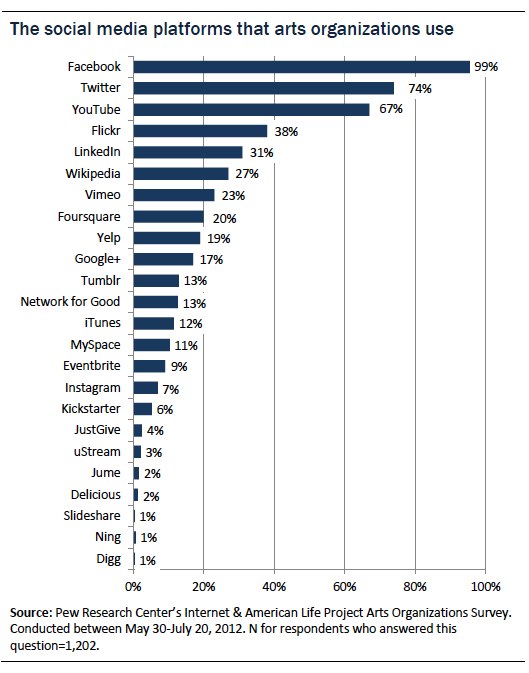
In the “other” category, 48 survey respondents listed Pinterest — a newer entrant on the social media scene — while others mentioned Skype, Songkick, and Crowdrise.5
While Facebook, Twitter, and YouTube are the most popular social media sites in which these arts organizations engage, participation was not limited to these three. In fact, the majority of arts organizations that use social media — 56% — have a profile on between four and nine social media sites. Some 10% of the arts organizations surveyed that use social media noted they are active on 10 or more platforms.
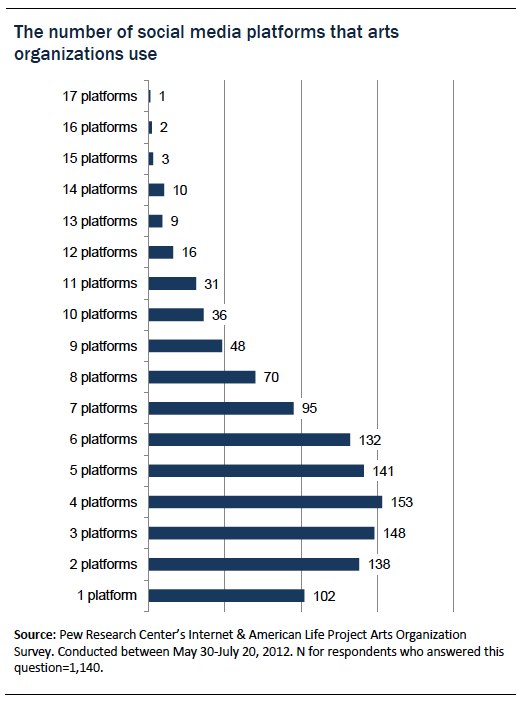
Adults who connect with the arts through social media are much more engaged
In an August 2011 nationally representative telephone survey of U.S. adults, conducted by Pew Research Center’s Internet & American Life Project, respondents were asked about different ways they engage with cultural institutions such as museums, arts organizations, and performers. At that time:
- 44% of all adults had attended a live music, dance, or theater performance in the 12 months prior to the survey; among those who follow a music/dance/theatrical group or venue on a social networking site, the figure climbs to 77%
- 35% of all adults had visited a museum in the last 12 months; among those who follow a museum on a social networking site, the figure is more than double at 82%
- 35% of all adults had attended an arts, craft or music festival in the last 12 months; the figure is 55% when looking just at those who follow individual artists, musicians or performers on a social networking site
- Finally, 29% of all adults had visited an art gallery, show, or exhibit in the last 12 months. The figure is almost three times as high (82%) among those who follow an art gallery or other visual organization on a social networking site
These data suggest that adults that connect to arts and cultural organizations through social media are much more likely to attend events and exhibits than those who do not. Presumably, many adults who follow these institutions on social media do so because they are already patrons. Yet given their power to “hook” patrons and expand audience through these platforms, arts organizations may see tremendous dividends in social media properties that are informative, engaging, and relevant to their audience.
Managing social media profiles
Although these social media platforms are usually free to join and to use, there are other costs to using them, including dedicating staff time and resources to keeping these profiles fresh, relevant, and active. An earlier open-ended question revealed that arts organizations recognize the potential and reach of these social sites, but also are concerned that social media require constant tending, proper staff training, and management to make them effective.
The survey asked respondents who use social media if there are specific staff members in their organization tasked with managing social media sites. Some three-quarters (76%) of those social media-using groups reported they have full-time paid staffers tending the sites; 29% have part-timers doing the job; 16% have volunteers doing it; 8% have paid contractors. However, this question allowed for multiple responses, and 13% say their social media profiles are managed by a combination of full-time and part-time staffers, while 13 organizations (1%) are using a combination of staff, outside contractors and volunteers.
Even with a large percentage of these arts organizations using paid staff to manage their social media profiles, it seems this task is often added on to existing work. Only 27% of these social-media using arts organizations state that they have a staff member whose position is dedicated to social media management, while 76% say they have staffers who oversee social media while also doing other things for the organization.
How often organizations post
Arts organizations in the survey that report using social media were also asked about the frequency of their posts: almost half (45%) say they are posting to social networks daily, including 25% who post several times a day. Just over one-quarter (28%) post content “several times a week,” while another 16% post “once a week.” The remaining 11% of social-media using organizations post less frequently. Even with staff capacity issues, these figures suggest that many arts organizations see social media activity as an important part of their workflow, and one that requires frequent tending to keep content up to date and relevant.
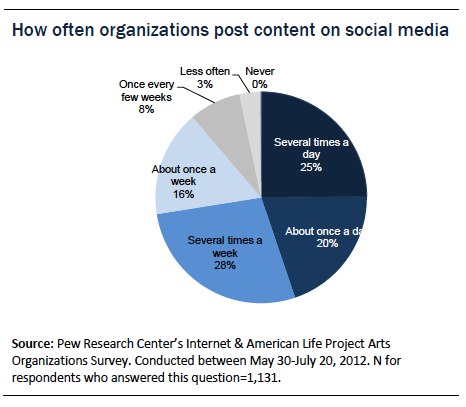
How they use social media
The arts organizations that use social media say they are using these applications for a range of activities.
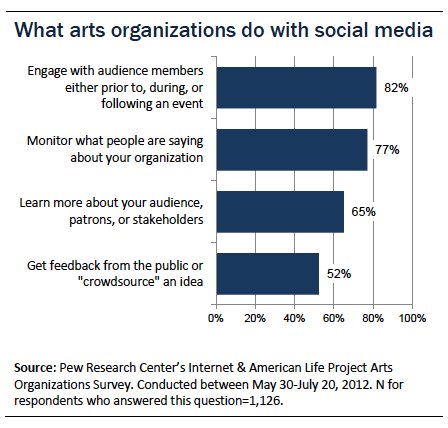
Engaging with audiences: 82% of the arts organizations participating in the survey that use social media state that they use these tools to engage with audiences before, during, and after events. Responses to additional questions in the survey underscore how integral social media has become for organizations that host events; social media help with audience awareness of and reminders about upcoming events, as well as marketing and promotion. Social media also give organizations the ability to link directly to ticket sales, offer last minute discounts, or alert attendees about program changes. Finally, social media do what traditional forms of marketing does not do; create a viral buzz through the sharable nature of information on social networks.
Monitoring organizational profile: 77% of the social-media-using organizations use these networks as a social barometer, to monitor what patrons and the public are saying about their organizations.
Gathering information and input: Nearly two-thirds of organizations (65%) that use social media say they use the tools to learn more about their patrons through more direct communications, as well as online surveys and polls. In addition, over half of organizations (52%) have used social media to crowdsource an idea, from possible programming decisions to the best times for sessions or seminars.6
Social media’s impact
Survey respondents were asked about the perceived impact that social media have on their organization. Fifty-six percent of the social-media-using organizations say it has a “major impact” on boosting their organization’s public profile, while 53% say it has a “major impact” on their engagement with the public. Social media are also seen by many organizations as helping them increase their website traffic, promote events, and build audiences. These social platforms are more often described as having a “minor impact” on fundraising, product sales, and public education, among other things.
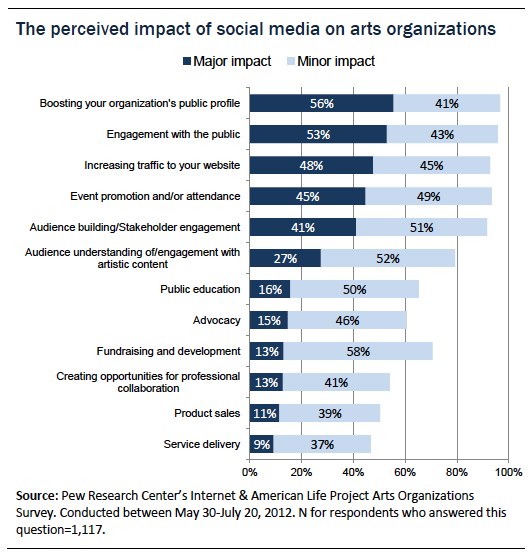
Survey participants were asked to recount any specific major impacts that social media have had on their organization’s work. More than 230 respondents provided examples in an open-ended question.
Social media help organizations clarify what they do, and better describe how audiences can engage:
Social media has helped us define our brand more clearly to broad audience that wants to engage, rather than just visit a webpage.
Social media gives us an opportunity to have a more casual interaction with our fans. Hopefully making us more approachable, interesting and engaging on a level that ultimately helps us connect with and expand our audience (and the diversity of our audience).
Social media deepens our relationships – about 70-80% of the people who regularly like, comment on, or repost our content are donors. Social media provides an additional vehicle for them to engage with – and support – our work.
Connecting our theater patrons with our education work and connecting our educators with our performance work. It has made our organization more integrated.
Social media also help organizations communicate with alumni, patrons, and audiences:
Keeping in touch with our alumni and engaging them in our current activities. Since college emails are shut down after a couple years, we lost electronic contact with most alumni who moved away from home. With Facebook we were able to “rediscover” hundreds of alumni.
Unlike most cultural programs, film programming comes and goes very quickly. Social media has given us the marketing agility we’ve long required to communicate with audiences about comings and goings and it has transformed audience numbers for us.
We do not have a consistent venue (we work with others all around the world), and we did not previously have a way of hearing from any of our audience members. Social media has provided that important feedback.
It also makes it possible for patrons to engage with each other, and for messages to spread:
We find that social media builds community around museum content. It allows the audience to engage one another based upon (and sometimes structured by) the material without being a controlled or linear experience.
When we post in the wake of an emergency, our fans tend to share our posts widely which helps our messages about the emergency relief that we provide reach exponentially more viewers than we could have just under our own steam.
Social media give organizations another way to measure outcomes:
For event attendance, we find that approximately 50% of people who respond ‘yes’ via Facebook do not actually attend the event.
Serves as a testing ground for interest in potential content. Allows for national participation in programs, including on the part of non-local artists. Allows for industry-wide conversation and goodwill support of sister organizations.
Social media make it possible for organizations to distribute special content to their closest followers:
Allowing our audience to see “exclusive” clips and trailers before they are aired to the general public. Making the audience feel interactive and inclusive.
For some organizations, social media have led to new partnerships:
Aside from face-to-face, Facebook has been the best way for us to communicate with our teenage students. Social media has also connected us more to businesses and orgs in the local community. We’ve been able to form a couple of beneficial partnerships that grew directly from contacts made over social media.
Social media also reduce marketing and promotional costs:
Utilizing social media and the internet as a communications tool has allowed our organization to reduce the amount of printed promotional materials needed. We can be more eco-friendly and still get the word out about our exhibitions and events.
Participation on these sites can also boost morale and provide organizations with much needed feedback:
Employee engagement with the organization through social platforms in real life has created a morale boost. Job postings and music education tips are always the most popular items we post.
Facebook has kept us visible in the public conversation and has expanded our base greatly. People know what we are doing and respond. We regularly post photos from performances and tours and get lots of feedback on them.
Finally, survey respondents say that social media have forced their organizations to confront the changing landscape:
It has forced staff, especially those age 40 plus, to recognize that the museum and library world is changing and they must adjust to greater demands by audiences and learn new approaches or be left behind.
Positive social media experiences
Asked to provide specific examples of both positive and negative outcomes from their social media use, organizations provided many examples. On the positive side, the most common responses related to:
- increased attendance at events
- more ticket sales
- increased public awareness of the organization
- an ability to support fundraising efforts
But, some organizations described specific success stories or clever uses of social media. For instance, social media give some organizations the ability to offer discounts and special ticket offers:
Several times our organization has made social media special ticket offers that have resulted in increased attendance at performances.
At one of our annual fundraisers, we offered a special price only through social media. In the week before the event, we sold more than the one-third of the eventual total attendance. We attracted a younger audience, grew the total numbers and spent no money.
It gives organizations a way to involve audiences in programming decisions:
We ask our fans to suggest performers/exhibits/films they’d like to see, which helps us plan and gives us ideas of the types of things they are interested in. We ask for suggestions every few months. Those suggestions are compiled into a list, and we research each of them to determine what might be a good fit.
We asked our Facebook page if they would like to see comedian Gabriel Iglesias. They affirmed he would be a good choice, we booked him, and sold out the show without spending a dollar on marketing.
It also gives organizations the ability to promote and sell out shows without spending money on traditional marketing:
Our summer children’s program was completely filled last year and advertised ONLY on Facebook. The previous year, we used more traditional methods of advertisement and were only at half capacity.
I was offered an add on performance of the national tour of CATS. I rarely add shows outside of season. Rum Tum Tugger was being done by an actor who had graduated from a local high school. His grandmother and mother called and asked if I was going to do the show, and guaranteed they could sell the house out. On our Facebook page we challenged our friends to show their support and friend us and tell us how many tickets they would buy and friends they would bring. Developed a buzz and we had people email us their name and email address. We surveymonkey’d them and found out how many tickets they would order. Sold out one whole show of CATS with no advertising, ended up having to add another show, that we did some advertising on. Built an enormous amount of support from this neighboring community.
Social media give arts organizations a way to personally communicate with patrons:
Social media allows us to interact with our patrons in a way we haven’t been able to before. After seeing that a patron has checked into our venue or has been talking about how good our show was, we thank them publicly and invite them back. This gives us the ability to create a personal interaction with them and create a connection that encourages them to come back. Sometimes our actors will join in when they see us thanking a patron, and send a personal thanks from the cast.
And, the ability to “broadcast” timely pieces:
Social media, and in this case YouTube, has helped us tremendously to get our message out to the world beyond our four walls. When SB1079 passed in Arizona, our organization (who specializes in Mexican music and dance), in the matter of days, was able to write, record and make a video of a song that directly addressed the issue. The video was posted on YouTube and got hundreds of hits in the matter of days. It was a way for us to execute our mission to a large audience in a short amount of time.
It can help arts organizations tap into a groundswell of support for the arts:
A few years ago our city wanted to cancel a contract with a Public Art project. It was already approved, they just wanted to take back the money. We don’t frequently engage in advocacy (only on the big stuff, just too much other work to do), but this would be a very bad precedent. So we exercised our social media tools to raise awareness, coordinate a panel discussion, and eventually a gathering at the city council meeting. Today the project is complete and in place.
We were the subject of comments concerning funding and donations from our local “Tea Party” and our patrons responded in full with comments, examples and telling our story in a stronger and better way than even our staff would have been able to do. We were proud that we did not have to, in any way, defend our value to the community, our audience did this for us.
It gives them the ability to curate and organize arts-related events in new ways:
We staged a series of “surprise” pop-up events during one exhibition that were only announced via social media to generate excitement and a spontaneous feel for the programs. Very successful and events were then reposted by attendees.
Engaging audiences in fun conversations is positive and helps build affinity for an organization. On one occasion we solicited ideas for how to name our “signature cocktail” at an upcoming benefit, based on the theme of the benefit. Facebook fans wrote in with lots of ideas, we picked our top favorites, and then released a poll so fans could vote on the name we ended up using. It generated awareness of the event (which was a record success) and allowed those who might not have been able to attend the event due to its ticket price a way to engage with the party.
And a way to reach new audiences:
We have effectively used social media to increase buzz, increase ticket sales and broaden audience diversity for more “edgy” works – primarily contemporary operas presented in a more intimate chamber format.
All classes are posted and promoted on our Facebook page. Event pictures that are posted on our Facebook page from our annual major fundraising event reach new people when their friends on Facebook are tagged in our photos.
We presented a live performance of a Pakistani artist and live-streamed it, receiving thousands of audience members from across the world. The materials on the program have continued to receive wide response and give the program an evergreen impact, lasting long afterwards. It will provide opportunity to compare with other similar programs.
Social media can generate materials for future fundraising and grant writing, and can even lead to grants in some cases:
We have received many positive comments through our blog and Yelp – which we have used for promotional purposes as well as grant applications.
A recent grant opportunity only came about because the funder was impressed by the size of our social media following and its level of engagement with us on our Facebook page. As a result, we received a sizeable grant because of the widespread support from our Facebook community.
It also gives organizations a new way to strengthen relationships with local sponsors:
We established Sponsor Fridays to highlight and thank sponsors of upcoming events. This has resulted in several new sponsors coming on board who have indicated that they learned about opportunities through our social media platforms.
It can also build social goodwill and celebrate the arts:
Because I believe in experience, my first attempts to use Twitter was to create TwitterMoves, wherein I tweet a daily creative dance prompt out to the unknown. I was thrilled to learn that dance teachers were using these tweets as eeds for developing curriculum, as opportunities to engage reluctant learners and to teach life skills to students with special needs.
The utter joy of our organization around one of our commissioned operas winning a Pulitzer was borne throughout the internet by Twitter and Facebook, allowing all of our patrons and fans to celebrate with us at such an achievement. Not just our patrons got into the spirit of the success, but also our fellow opera companies and artists who we’ve engaged, whether or not they are often returning visiting artists.
Negative social media experiences
In addition to the varied positive impacts noted, the arts organizations surveyed here recounted some negative outcomes related to social media use. A handful of organizations mentioned common issues such as:
- Social media taking up too much staff time, when there is more important work to do
- Self-serving posts on Facebook where artists are using the organizations’ profile to promote their own work or different events
- Spam cluttering up Facebook or Twitter pages
- Spam comments on website or blog
- Accounts being hacked
But, by far, the most common response about negative outcomes related to unfiltered public criticism of the organization. Platforms like Facebook, Twitter, and Yelp give the public easy opportunities to air grievances, disagree with programming decisions or complain about customer service issues. And, unlike in the past when such problems were managed one-on-one by staff via phone or email, social media displays these complaints for any reader to see.
Many organizations mentioned instances where patrons had posted critical comments on Facebook or Twitter. However, a number of respondents talk about how they have used negative comments to fix problems and better serve patrons:
The community that follows us is very supportive. If there has been a problem with a product or something, we respond quickly and leave the comments up so that if someone else has the same problem they know we are fixing it.
We get customer complaints via social media, but we address those just like we do any other customer complaint: identify the problem, apologize if we can, fix it for next time, notify the public about the change/fix.
A number of organizations mentioned that other patrons on social media have stepped up to problem-solve or defend their work:
When someone posts a complaint on Facebook or Twitter, more times than not one of our other patrons (not a staff member) will step in and address the complaint, acting as our advocates. Social media has allowed us to become more connected with our fans, so even when they have a problem and are discussing it online, we are presented with an opportunity to show exemplary customer service and address the problem directly… I much prefer our doing this than our never knowing of the issue and allowing it to fester.
Any time you engage in social media, you open yourself up to negative feedback. But by building and engaging with a group of brand advocates on social media, when we do experience negative feedback, it is often answered by peers as opposed to the institution. An example of this would be announcing our summer concert series, and having someone not like one of the many guest artists we bring in. However, for every negative comment, there is usually someone with a different opinion.
While most of negative comments on social media are relatively manageable, some organizations described instances where comments led to larger issues. A few talk about how negative comments can harm their public profile:
We provide grants and an organization who was unhappy about not receiving a grant posted some negative stuff on Twitter. While we responded and kept it professional, it did put negative comments out there associated with our profile, potentially damaging our brand.
People who didn’t get tickets for one of our popular performances took to Facebook to express their displeasure with us, which created an outlet for dissatisfied customers to bash us. The media took some of these negative posts and used them as quotes in a story.
Some organizations have had to deal with abusive comments:
Our organization has suffered from the rants of a very negative person. He has taken great strides to post negative comments on our social networks. We have tried to meet with this person, but he refuses and we continuously have to remove his posts from our networks.
There were some other negative outcomes from social media use. Some organizations talk about how easy it is to accidently abandon patrons by communicating through selective channels:
Because we do a lot of work in rural areas, with senior citizens, and low income areas, social media only works for a portion of our audience. Getting everyone informed of a last minute change or spontaneous program simultaneously is tricky without overlooking certain portions of the population. A heavy reliance on social media, though convenient, can exclude many people.
Another pointed out that social media makes it much harder to keep a secret:
The use of social media is so prevalent to everyone these days, sometimes it is hard to keep confidential matters confidential – especially on a film shoot. Crew members are apt to identify location, client, storyline, etc. and broadcast them to friends and family, which in turn get back to client.
A few respondents mentioned the difficulty in setting employee policies that respect freedom of expression, but also protect the organization’s brand:
Before we put policies in place, one of our employees, who was a great social media user, kind of merged his own identity on Facebook with that of our organization. Therefore, when he also would party and post about it – it became an area of discipline. And he didn’t understand the need for separating these things out, keeping his personal life off of our public profile. That was several years ago.
Employee and constituent had an argument on our Facebook page, became heated, and employee had to be let go.
We had a staff member who crossed the boundaries between personal and professional. On her own Facebook she wrote disparaging things about us, and though she did not identify us by name, it was not disguised either. We have struggled with free expression among younger staff around museum issues and have not come to a good resolution. There are varying opinions about social media and right now the old, conservative guard are in control.
Others mentioned the challenges of using social media without a full understanding of the technology, or having appropriate institutional policies in place:
In the past we’ve had young, eager employees who were more enamored with social media than doing a good job at work take on “launching our organization into the 21st century.” We trusted their expertise, but in fact, they were not skilled in thinking about the right use of each technology for our agency and left us with confusing messages, as well as taking our passwords with them. We spend way too much time trying to re-call and reclaim lost user names and passwords.
We sent out an email blast to over 22,000 email subscribers for an event that had only 30 slots and it sold out so quickly that we received a bit of backlash about it. We should have calibrated it better.
Overall, responses to these open-ended questions suggest that social media’s benefits outweigh the drawbacks for most organizations.
Social media’s value to arts organizations
Survey respondents were asked to gauge the value of social media based to their organization in a series of statements about the potential impact of these tools. For 58% of organizations that use social media, the phrase “Social media is worth the time our organization spends on it” is “very true,” while another 33% thought it is “somewhat true.” There is also broad consensus around the statements that social media helps organizations reach new, broader audiences, and that it helps audiences feel more invested in arts organizations.
Survey respondents were also asked about some of social media’s inherent challenges. Seventy-four percent of these organizations thought it is “very true” or “somewhat true” that they do not have the staff or resources to use social media effectively, a sentiment that is reflected throughout the survey, while other organizations commented on the generational differences amongst staff members regarding use. Interestingly, 85% of organizations say it is “not true at all” that “social media creates more risks than benefits” for their organization, reinforcing the idea that the arts field sees more positive than negative outcomes using and employing these new tools.
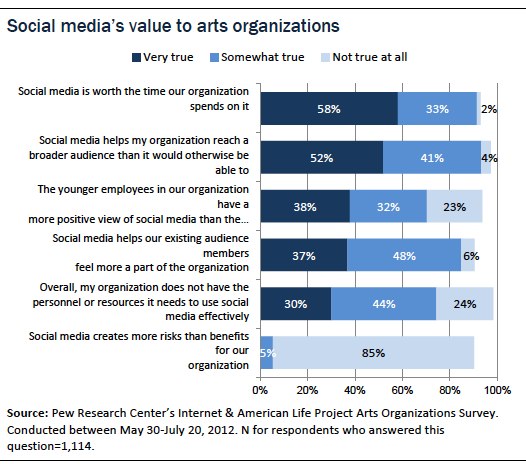
Why some organizations don’t participate in social media
Less than 4% of the organizations responding to the survey are not currently using social media. For these non-participants, “reliable access to resources” and “a lack of a trained staff” are the primary reasons they have not yet engaged these tools. However, for a few organizations – especially those that work with children, youth at risk, and immigrant populations — the use of social media may conflict with their effort to serve their constituencies.
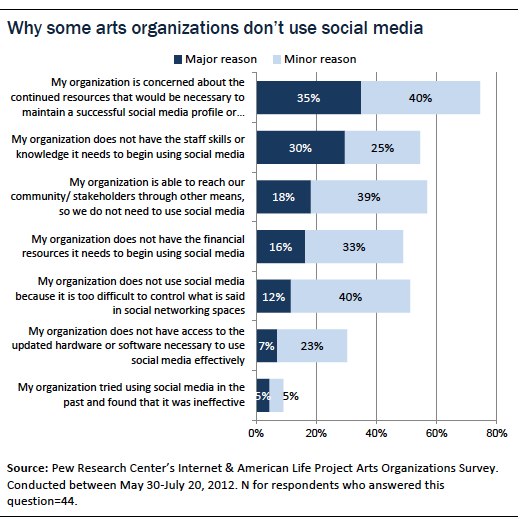
The sentiments expressed in this survey about the use and impact of social media suggest that arts organizations have quickly embraced these new platforms, with 97% of responding organizations using at least one social media platform. Posting content weekly or daily, arts organizations are using these platforms to engage with audiences, promote events, raise (and monitor) their organizational profile, communicate with patrons, streamline their workflow, and reduce marketing costs. But, survey responses reveal this is still a transitional time. Arts organizations noted that social media exposes them to public criticism, has forced them to evaluate their employee conduct rules, and develop strategies that take their participation in these platforms into account. Overall, arts organizations agree that participating in social media is worth the time spent, but as with other technological endeavors, it takes time and planning to do it right.




